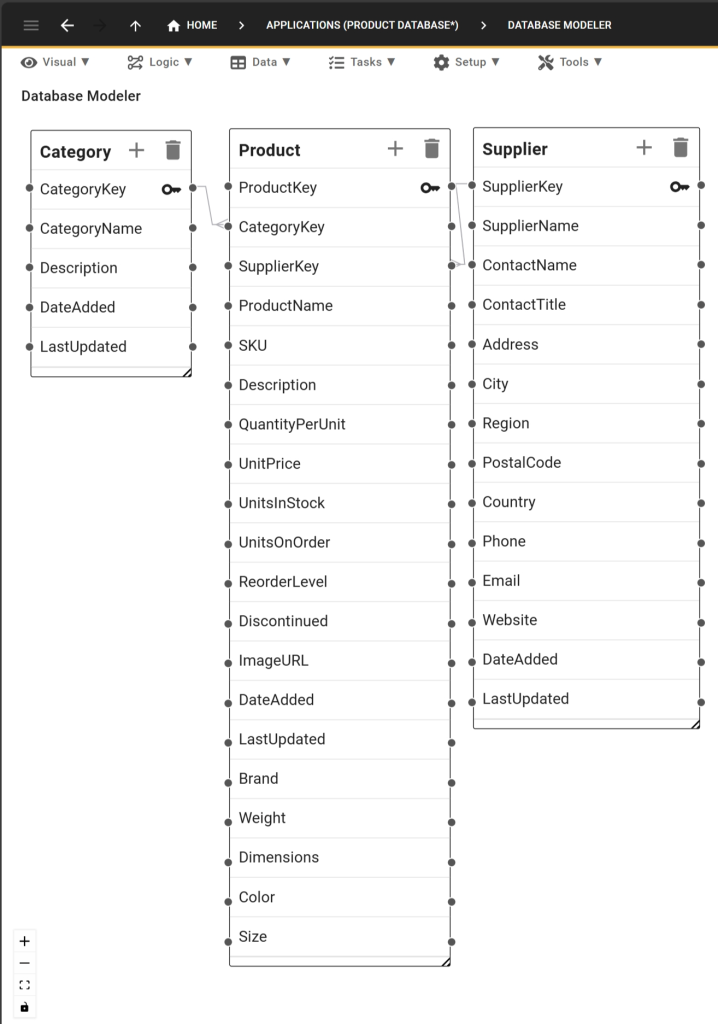Create a Warehouse Database In 3 Steps
Create a Warehouse Database: Sample Included
A warehouse database is key for both physical and e-commerce businesses. It tracks stock levels, product details, and supplier information, acting as the central source of truth for warehouse management. A well-structured warehouse database can improve operations and minimize errors.
If you’re unsure where to start, this guide will walk you through the process of creating an efficient warehouse database, helping you eliminate issues like lost inventory and inaccurate tracking.
Let’s go ahead and learn how we can develop a warehouse database. Scroll down to access a free template application that stores data about products, shipments, and suppliers.
Why Build a Warehouse Database?
A warehouse database is vital for efficiently managing your inventory. It allows you to monitor stock levels, handle orders, predict demand, and prevent stock outs or overstock situations. By centralizing your data, you maintain consistency and make well-informed decisions about the inventory you control.
What Is a Warehouse Database?
A warehouse database stores detailed information or attributes about items in your inventory, such as item name, weight, color, material, size, price, discount levels, minimum order quantity, country of origin, images, category, description, packaging information, margin, production cost, supplier details, and variations.
Depending on your industry, you might also track attributes like certifications (e.g., “certified organic,” “GMO-free”), sensory characteristics (e.g., “sweet,” “soft”), ingredients, or marketing claims (e.g., “long-lasting,” “top-rated,” “popular choice”).
For example, if you manage a warehouse for an e-commerce business selling office supplies, platforms like Shopify can handle attributes such as price, color, size, and material quality. However, these platforms might not support storing extensive information like detailed item IDs, supplier details, input materials, production costs, margins, or packaging requirements.
This is where a dedicated warehouse database becomes crucial. It acts as a comprehensive, searchable system that consolidates all inventory attributes, facilitating efficient management and detailed tracking of all relevant information.
Why Spreadsheets Don’t Work for Warehouse Databases
Many businesses initially use tools like Microsoft Excel or Google Sheets to create their warehouse databases. While convenient for small operations, these spreadsheet-based solutions often encounter significant problems as the business grows:
- Version Confusion: Different users or departments may have their own copies of the spreadsheet, leading to multiple versions such as “WarehouseDatabase_NEW,” “Warehouse Database – v2.1,” “Old Warehouse Database – DO NOT USE,” etc.
- Lack of Version Control: Without clear ownership or version control, changes made by various team members can be lost or duplicated, especially if the person responsible for updates leaves the company.
- Data Inconsistencies: Manual updates, comments, and highlights can clutter the spreadsheet, resulting in errors and inconsistencies. For instance, marking out-of-stock items in red can easily be overlooked or misinterpreted.
Using spreadsheets for your warehouse database ultimately undermines the goal of having a single, reliable source of truth. Instead of efficient warehouse management, you end up managing and cleaning up multiple spreadsheets constantly.
Building a dedicated warehouse database solution with a tool like Five, can help overcome these challenges by providing a centralized, consistent, and reliable platform for your warehouse management needs.
How to Create an Warehouse Database in 3 Steps
Building a warehouse database typically requires technical knowledge that someone running an e-commerce or factory operation might not have. For instance, you’d need a substantial understanding of database languages like SQL, in addition to the frontend development required for user interaction.
This complexity often leads small-scale e-commerce operations, manufacturers, and distributors to neglect building a warehouse database because they lack the technical expertise or the time to create it from scratch.
This is where database builders like Five come in. Five is an online database builder specifically designed to make creating a warehouse database much faster and easier.
Creating a warehouse database with Five won’t be entirely effortless, but it will be significantly easier than spending 60+ hours learning various coding frameworks and languages.
With Five, you can set up your database in minutes, and a user-friendly interface is automatically generated based on your database structure. You can easily import your existing data from Excel, Google Sheets, or CSV files, allowing you to get started quickly.
Five also offers the flexibility to create custom business logic with code, generate stocktake or inventory PDF reports, and visualize your data through custom charts. Additionally, you can set up email notifications for low stock items, ensuring you stay organized and never run out of essential inventory.
Moreover, your database will run on any device, so whether you’re using a tablet in the warehouse or a desktop in the office, you can manage your database efficiently.
To create your warehouse database in Five, follow these steps:
- Sign up for free access.
- Create a custom warehouse database (or start with our template).
- Add forms to your database.
- Create unique user logins for internal staff, external suppliers, or business partners.
Five has a team of experts ready to assist you with your development and customizations. So, if you ever feel like you’re in need of a new dashboard or a form field, don’t worry, our expert developers are here to help. And yes, we promise not to charge you an arm and a leg or leave you with a system that only we understand!
Step 1: Identify and Document Warehouse Attributes
Start by identifying and documenting all attributes relevant to your warehouse inventory. Consider what matters to your business, your customers, and your employees. Your warehouse database should serve as a “single source of truth,” so ensure it’s as comprehensive as possible.
Here are some essential attributes typically included in a warehouse system:
- Item ID
- Item Name
- Description
- Price
- Materials or Ingredients
- Size(s)
- Weight
- Color(s)
- SKU (Stock Keeping Unit)
- Supplier Details
- Minimum Order Quantity
- Packaging Information
- Country of Origin
- Current Inventory Levels
- Units on Order
- Reorder Level
Step 2: Define Other Information
Beyond storing detailed information about your items, your warehouse database should track how inventory moves through your business.
Identify and describe these interactions:
- Receiving Shipments: Track information such as shipment ID, supplier, arrival date, and received quantities.
- Stock Movements: Monitor movements within the warehouse, such as transfers between locations or shelves, with details like transfer date, origin, and destination.
- Order Fulfillment: Document orders leaving the warehouse, including order ID, customer details, shipment date, and quantities shipped.
- Quality Control: Record inspections, including inspection date, item condition, and any actions taken.
The more information you gather, the better your analytics will be. For example, if you want to analyze trends in stock levels or supplier performance, it’s crucial to store this data from the beginning.
Step 3: Creating Your Warehouse Database
With your list of warehouse attributes and additional information ready, it’s time to move all of this into a proper database.
To do so, sign up for Five, an online database builder that comes with a simple point-and-click interface for creating relational databases.
Follow our video tutorial to build your database tables, forms, and reports, and start managing your warehouse efficiently.
Warehouse Database: Free Sample Application
Explore this sample warehouse database, created in just 15 minutes, featuring 13 warehouse attributes in an easy-to-use web interface. Feel free to add more items to the database and navigate through the application.
The Warehouse Database Schema
Here’s the database schema for our application:
- Product Table: At the core of the database, this table stores information about products and their attributes.
- Category Table: This table helps classify products into their respective categories, making it easier to organize and retrieve items.
- Supplier Table: A critical component of the schema, this table links products to their suppliers and enables us to notify suppliers when inventory levels are low.
Each table holds specific information, such as product details, reorder levels, supplier contact information, and product categories, ensuring a comprehensive and organized structure. The relationships between these tables facilitate efficient warehouse management.

Get Started with Five Today
To build your warehouse database with Five, sign up for free access and start the process. If you need assistance, visit our forum to get help from our application development experts as you add more features to your database application.
By following the steps mentioned above, you can create robust and scalable warehouse software tailored to your needs, all while using the tools provided inside of Five.


